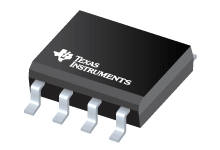Datasheet Texas Instruments UCC28C42D
| Manufacturer | Texas Instruments |
| Series | UCC28C42 |
| Part Number | UCC28C42D |

BiCMOS Low Current 8 Pin PWM Current Mode Controller 8-SOIC -40 to 105
Datasheets
UCCx8C4x BiCMOS Low-Power Current-Mode PWM Controller datasheet
PDF, 3.8 Mb, Revision: G, File published: Jan 10, 2017
Extract from the document
Prices
Status
| Lifecycle Status | Active (Recommended for new designs) |
| Manufacture's Sample Availability | Yes |
Packaging
| Pin | 8 |
| Package Type | D |
| Industry STD Term | SOIC |
| JEDEC Code | R-PDSO-G |
| Package QTY | 75 |
| Carrier | TUBE |
| Device Marking | 28C42 |
| Width (mm) | 3.91 |
| Length (mm) | 4.9 |
| Thickness (mm) | 1.58 |
| Pitch (mm) | 1.27 |
| Max Height (mm) | 1.75 |
| Mechanical Data | Download |
Parametrics
| Control Method | Peak Current Mode |
| Duty Cycle(Max) | 100 % |
| Frequency(Max) | 1000 kHz |
| Frequency(Min) | 26 kHz |
| Gate Drive(Typ) | 1 A |
| Operating Temperature Range | -40 to 105 C |
| Package Group | SOIC |
| Rating | Catalog |
| Special Features | Error Amplifier,Multi-topology |
| Topology | Boost,Buck,Buck-Boost,Flyback,Forward |
| UVLO Thresholds On/Off | 14.5/9 V |
| Vin(Max) | 400 V |
| Vin(Min) | 14.5 V |
Eco Plan
| RoHS | Compliant |
Application Notes
- UCC38C44 12-V Isolated Bias Supply (Rev. A)PDF, 324 Kb, Revision: A, File published: Oct 9, 2008
This reference design describes a discontinuous, peak current-mode flyback converter whose input voltage is generated from the output of a universal power factor correction circuit. The converter is designed to operate at a switching frequency of 225 kHz, requires minimal parts, and supports an isolated 12-V, 3-W output and a non-isolated 12-V, 1-W output ideally suited for chip bias and voltage f - UCC38C42 25-W Forward ConverterPDF, 320 Kb, File published: Sep 6, 2002
This reference design presents a self-resonant reset forward converter using the UCC38C42 BiCMOS Low-Power Current-Mode PWM Controller. The input voltage for this converter is compatible with the telecom input voltage range of 36 VDC to 72 VDC. The converter is designed to operate at a switching frequency of 525 kHz, requires minimal parts, and supports an isolated 2.5-V 10-A output. The complete - DN-62 Switching Power Supply Topology Voltage Mode vs. Current ModePDF, 66 Kb, File published: Sep 5, 1999
This design note explains the differences between voltage-mode and current-mode switching power supply topologies. It includes a circuit diagram for each mode and suggests criteria for choosing which mode to use. - UCC38C42 Family of High-Speed BiCMOS Current-Mode PWM ControllersPDF, 280 Kb, File published: Feb 7, 2002
Since their introduction in the mid 1980?s the bipolar UC3842 family of Pulse width modulation (PWM)controllers has grown to become the most widely-used control strategy in the power supply industry. [1] The reasons for success are quite clear the devices feature an elegantly simple yet very effective control architecture they use only 8 pins they can drive MOSFET gates directly and they offer - U-111 Practical Considerations in Current Mode Power SuppliesPDF, 787 Kb, File published: Sep 5, 1999
This application note explains the numerous PWM functions and ways to maximize their usefulness. It covers practical circuit design considerations such as slope compensation gate drive circuitry external control functions synchronization and paralleling current-mode controlled modules. Circuit diagrams and simplified equations are included. - DN-42A Design Considerations for Transitioning from UC3842 to the New UCC3802PDF, 42 Kb, File published: Sep 5, 1999
The UCC3802 offers numerous advantages that allow the power supply design engineer to meet requirements for lower power for battery-operated equipment higher switching frequencies for reduced magnetics size higher levels of circuit integration for improved reliability and lower cost. The UCC3802 family of devices is pin-out compatible with the UC3842 and UC3842A families; however it is not plu - Conditioning a Switch-mode Power Supply Current Signal Using TI Op AmpsPDF, 61 Kb, File published: Mar 23, 2000
The switch-mode power supply primary current is often sensed using a power resistor. Using an op amp to amplify the current-sense signal can reduce cost and improve noise performance and efficiency. This report reviews the advantages of using an op amp circuit and analyzes the design criteria needed to choose the proper op amp. - Understanding Buck-Boost Power Stages in Switchmode Power Supplies (Rev. A)PDF, 363 Kb, Revision: A, File published: May 28, 2002
Model Line
Series: UCC28C42 (7)
Manufacturer's Classification
- Semiconductors > Power Management > Offline and Isolated DC/DC Controllers and Converters > PWM and Resonant Controller
